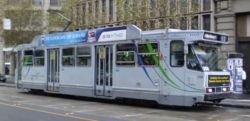Electric Railroad
 From Conservapedia
From Conservapedia An electric railroad (Britain: electric railway) is a railway line operated by means of electric power.
Contents
- 1 Methods of power distribution
- 1.1 Third and fourth rails
- 1.2 Overhead wire
- 2 Voltage
- 3 Dual (and more) voltage locomotives
Methods of power distribution[edit]
There are two main methods of carrying the electric current from power stations to the trains: via an overhead wire and by an extra rail.
Third and fourth rails[edit]
The earliest electric railways used a third rail either between or outside the "running rails" (the rails the trains' wheels run on) to carry power. A "shoe" or contact on the train slides on this rail to collect the current, which is returned via the running rails.
Gaps must be left in the third rail for level crossings, and other tracks crossing the lines. Trains usually have more than one collection shoe, so that at least one is in contact with the third rail at any one time. If not, they need to coast across the break in the third rail.
Alternative schemes add a fourth rail for the return current.
Overhead wire[edit]

Most electric railways use an overhead wire to carry power. A collector, usually in the form of a pantograph, collects the current, which is returned via the running rails. An alternative to the pantograph is a pole with a wheel or shoe at the top which runs or slides along the electric wire.
Except for low-speed lines such as street tramways, the wire is usually suspended from a catenary wire with droppers, which are short vertical wires. This allows the contact wire to be kept very level, which is necessary for the speeds at which trains typically operate.
Voltage[edit]
Third-rail systems typically operate at 600 volts DC or 750 volts DC. Earlier suburban electrified railways with overhead wires typically operate at 1500 volts DC. Modern high-speed railways typically use 25,000 volts or 50,000 volts AC.
Dual (and more) voltage locomotives[edit]
Many locomotives in some European countries are built to operate on more than one voltage, and some are built to collect power from both overhead wires and a third rail.
Categories: [Railroads] [Electrical Engineering]
↧ Download as ZWI file | Last modified: 02/16/2023 18:51:25 | 3 views
☰ Source: https://www.conservapedia.com/Electric_railroad | License: CC BY-SA 3.0
 ZWI signed:
ZWI signed: KSF
KSF